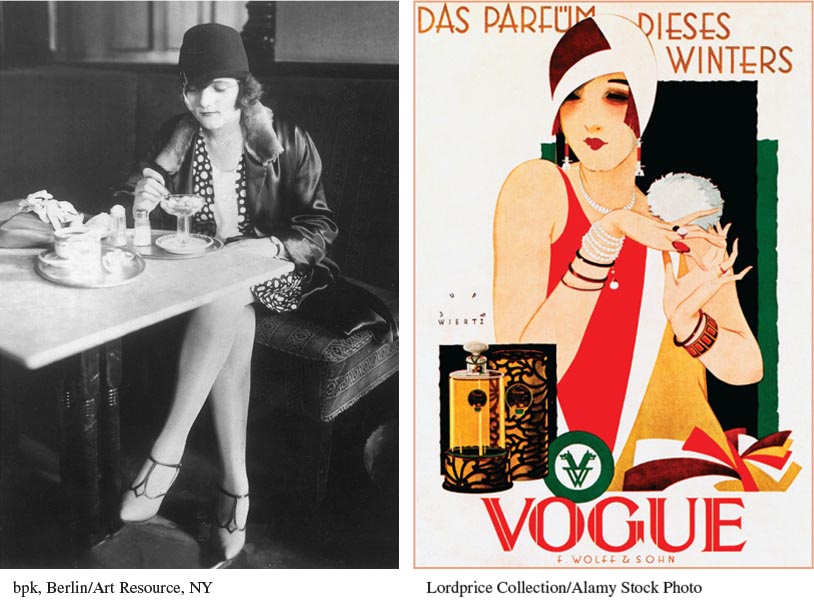A History of Western Society: Printed Page 881
A History of Western Society, Value Edition: Printed Page 845
A History of Western Society, Concise Edition: Printed Page 881
Mass Culture
The emerging consumer society of the 1920s is a good example of the way technological developments can lead to widespread social change. The arrival of a highly industrialized manufacturing system dedicated to mass-
Contemporaries viewed the new mass culture as a distinctly modern aspect of everyday life. It seemed that consumer goods themselves were modernizing society by changing so many ingrained habits. Some people embraced the new ways; others worried that these changes threatened familiar values and precious traditions.
Critics had good reason to worry. Mass-
Commercialized mass entertainment likewise prospered and began to dominate the way people spent their leisure time. Movies and radio thrilled millions. Professional sporting events drew throngs of fans. Thriving print media brought readers an astounding variety of newspapers, inexpensive books, and glossy illustrated magazines. Flashy restaurants, theatrical revues, and nightclubs competed for evening customers.
Department stores epitomized the emergence of consumer society. Already well established across Europe and the United States by the 1890s, they had become veritable temples of commerce by the 1920s. The typical store sold an enticing variety of goods, including clothing, magazines, housewares, food, and spirits. Larger stores included travel bureaus, movie theaters, and refreshment stands. Aggressive advertising campaigns, youthful and attractive salespeople, and easy credit and return policies helped attract customers in droves.

The emergence of modern consumer culture both undermined and reinforced existing social differences. On one hand, consumerism helped democratize Western society. Since everyone with the means could purchase any good, mass culture helped break down old social barriers based on class, region, and religion. Yet it also reinforced social differences. Manufacturers soon realized they could profit by marketing goods to specific groups. Catholics, for example, could purchase their own popular literature and inexpensive devotional items; young people eagerly bought the latest fashions marketed directly to them. In addition, the expense of many items meant that only the wealthy could purchase them. Automobiles and, in the 1920s, even vacuum cleaners cost so much that ownership became a status symbol.
The changes in women’s lives were particularly striking. The new household items transformed how women performed housework. Advice literature of all kinds encouraged housewives to rush out and buy the latest appliances so they could “modernize” the home. Consumer culture brought growing public visibility to women, especially the young. Girls and young women worked behind the counters and shopped in the aisles of department stores, and they went out on the street alone in ways unthinkable in the nineteenth century. Contemporaries spoke repeatedly about the arrival of the “modern girl,” a surprisingly independent female who could vote and held a job, spent her salary on the latest fashions, applied makeup and smoked cigarettes, and used her sex appeal to charm any number of young men. The modern girl had precedents in the assertive, athletic, and independent “new woman” of the 1890s, but she became a dominant global figure in the 1920s. “The woman of yesterday,” wrote one German feminist in 1929, yearned for marriage and children and “honor[ed] the achievements of the ‘good old days.’” The “woman of today,” she continued, “refuses to be regarded as a physically weak being . . . and seeks to support herself through gainful employment. . . .
Despite such enthusiasm, the modern girl was in some ways a stereotype, a product of marketing campaigns dedicated to selling goods to the masses. Few young women could afford to live up to this image, even if they did have jobs. Yet the changes associated with the First World War (see Chapter 25) and the emergence of consumer society did loosen traditional limits on women’s behavior.
The emerging consumer culture generated a chorus of complaint from cultural critics of all stripes. On the left, socialist writers worried that its appeal undermined working-
Despite such criticism — which continued after World War II — consumer society was here to stay. Ordinary people enjoyed the pleasures of mass consumption, and individual identities were tied ever more closely to modern mass-